page 11
(Using a philosophy of "threes" as a tool for comparative analysis)
http://threesology.org
Anat., Bio. Phys. Researchers as of 3/17/2021
Pages in this series:
| 1 | 2 | 3 | 4 | 5 | 6 | 7 | 8 | 9 | 10 | 11 |
While any number of interpretive definitions might be used in compiling information into a three-patterned display, some readers may be inclined to restrict their research to fairly narrow limits in the subject matter under study, though for some, this may involve multiple interests— since many of us like to dabble in various genres of intellectual pursuit. Nonetheless, if a topic is not recognized as a common textbook idea, they would prefer not to indulge in non-conventional contemplations, or perhaps find themselves being viewed as someone with questionable "alternative" views who can not be trusted to "keep the faith" as dyed-in-the-wool researchers do who attempt to "own" the language and ideas of one or two subjects in order to present themselves as an authority on a given subject of traditionalized study. However, labeling a topic as a genre of philosophy does not automatically afford someone a safe haven for exploring anything in any manner that they would like to. Since philosophy too has its conventions, one must explicitly state they are indulging in a creative or imaginative license in their discussions in order for readers to permit some latitude in explorations beyond the typical territories of conventionalized subject matter. Yet, an historical trek of those who have remained, for the most part, along the path of typical views seen in textbooks or spoken of by instructors whose career goals do not stray too far afield from their academic brethren, may not be capable of diverging into unconventional realms of consideration except with accepted ideas of unconventionality that they and their ilk describe as metaphysics or some museful preoccupation that they can share during some cocktail interlude for the purposes of social entertainment, without giving any serious attention to what is being conversed.
And with this said, let us indulge in such an esoteric field of exploration with respect to using the words "Anatomy, Biology, Physiology" in other ways and application, such as speaking of the anatomy, biology, and physiology of space, time, language, and other topics in which such words are not typically used as descriptive labels meant to provide illustrative metaphors that may enable an expansion of awareness through what some may view as linguistic transgressions heard when someone is inebriated by some recreational pastime of over-indulgence. Yet, it is much easier to create various contemplations without a goal in mind than it is to formulate a pattern of inquiry that may lead to findings far afield of the initial exploration. Patterns can arise from a compilation of patterns that turn into a more elaborate effort of research that is then subjected to the rigors of conventionalism that causes traditions to blaze a new trail or open up an old one that was forgotten or felt to pose too many obstacles at a given time... such as those explorers who sought to find a shorter passage only to become overwhelmed because they were unprepared to make adjustments to their old ways of approaching a perceived task.
Because such a field and type of exploration (as the "threes") is limited only by the vistas of one's imaginative capabilities, such discussions may traverse multiple topics at one time, giving those with more conventional interests cause for bewilderment... or suspect they are in the company of someone who has wandered off from their keeper. Some do not want to invest any time and energy (much less financially linked resources) to what appears to them as a waste of time because no definitive reward can be seen. Exploration is not a reward for them. They have no sense of adventure unless they are guaranteed an advantage or position of notability in which status grants them a measure of deferment. Nonetheless, it is good to remember that many of the ideas which we take for granted today (television, radio, space flight, germ theory, atomic theory, alien abduction, photography, monotheism, aircraft, fire works, cell phones, trains, blood typing, DNA, surgery, gun powder, refrigerators, washing machines, pencils, pens, animal rights activism, anti-Monarchialism, freedom, liberty, etc.,) would no doubt be viewed as topics which would have caused concern, fear or bewilderment... or even insanity... in former ages... particularly if such ideas were viewed as a threat by those in authority who were trying to advance their own types of ideas as a means of control or manipulation.
But, enough of such a digression into generalizations, let's continue where I left off on the previous page:
In continuing our discussion of limitation with respect to the quantization of design (such as the limitations seen in physics regarding the speed of light or speed of causality)... or at least to a stabilized easily observable appearance; we can add the example of foot type, though there is an absence of Asian and African examples in this presentation... and are only necessary if such are appreciably different from this selection. In other words, there are not multiple other variations being used as an expression of "diversity".
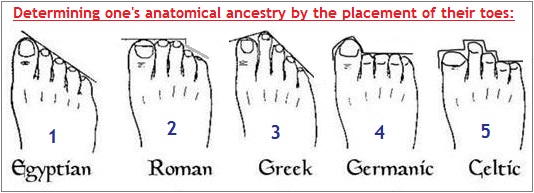
And if we look at the "toes" of human hands that are typically referred to as fingers (and thus fingernails), we see an additional limitation as well as another reference to the previous account of linear, circular and triangular forms:
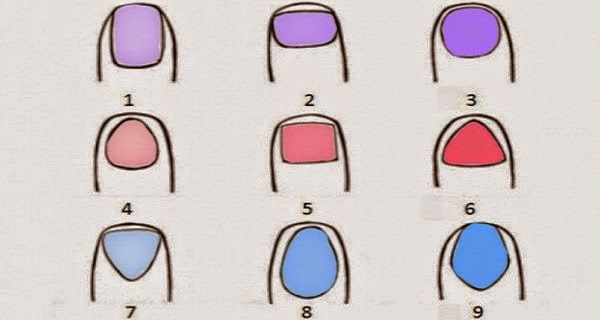
How Fingers and Nails Can Reveal One's Ethnic descendancy and Character Traits
On the flip-side of finger-nail patterns we find fingerprint patterns which fall into three general categories and are part of what is referred to as "biometrics", of which the FBI appears to claim itself as being second to none with its Biometric Center of Excellence, except that its leading experts may well be particularly ignorant about the "threes" phenomena as a distinguishable pattern in a relation to the presence of an overall incremental deterioration of the Sun-Earth-Moon trio of interactive bodies that are and will continue to affect the various cultures of human civilization. Criminal behavior is but one small aspect of human activity. While crime scene analysis may not be focused on such larger philosophical issues, the science of biometrics should be, since it might well then be able to predict future behavioral trends related to anatomy, biology, and physiology.
For example, there is the old view that there existed three races of humans, designated as African, Asian and Caucasian (or Asians from the Caucus region between the Black and Caspian seas). Despite the rejection of this idea by some who prefer to say there are more than three races, the "three" theme has been used time and again as a fundamental means of exploring the topic of human racial distinctions... even if the person reading this feels they are a mixture of all three and therefore constitutes another race, just as some homosexuals view themselves as a third (and sometimes superior) type of hominin, though the terms "third sex" or Third Gender might be used.
What is more likely the case is that we are viewing multiple variations of humans living contemporaneously, whose different survival specializations exhibit differentiated environmental pressures, of which the recurring usage of a limited number and type of patterns is a tale-tell indication of the incremental deterioration of the planetary system and rationalized adjustments being made in an attempt to maintain some measure of equilibrium, like a deteriorating ocean raft on filled with people who vie for relatively safe and secure positions... as food, water and shelter provisions continue to dwindle. Homosexuals and their ilk are so caught up in their sexuality that it is a hang-up from being able to define themselves then by a primitive narrative, like children learning to differentiate which gender they are and define their world-view in accordance therewith. Because there is an over-riding preoccupation with identifying themselves and others according to their sexuality, one may consider this to be an indication that they are in the presence of a primitive species that can not reach a level of sustained contemplation above and beyond basic body functionalities which are distorted away from procreative exercises as if this were an advanced practice of intellectual considerations.
But in a topic such as "race", we need to have some measurable definition such as the division of a species, genetic similarities versus dissimilarities, or some other scheme of reasoning. Generally speaking, we often describe race when referring to a group, whereas an isolated difference in a single individual might be viewed as a (good or bad) anomaly. Some might argue that there is only one human race with many ethnic groups, while others argue that the different ethnic groups constitute bona fide races. Whereas there has been a recurring usage of identifying three races (Caucasoid, Mongoloid, Negroid), in an anthropology course one might encounter the usage of four distinctions (white/Caucasian, Mongoloid/Asian, Negroid/Black, and Australoid). However, one might want to cite the historically frequent usage of an "Us versus Them" distinction to represent two races. If we look at the image below and describe each infant as belonging to another race, what we say if all of them came from the same mother and father? Or if they all had the same color of skin but showed variations in height, weight, hair and eye color, as well as whether they were intelligent or otherwise gifted or talented. No less while one may argue that artificial or contrived breeding amongst planets and animals may or may not constitute a different species, we must also include the artificial and contrived births due to impositions and requirements of age, religion, rape, adultery, incest, social class, what schools one attends, music interests, sports interests, family values, business interests, killing of female infants because males are thought to be more useful, etc... All such events constitute the makings of artificial breeding grounds... then again, what constitutes a "Natural" breeding ground, when all breeding grounds are subjected to selective pressures?
But let's ask some other types of questions:

- Are females to be considered a different race or even different species from males?
- Do the different races of humans actually constitute different species, though there are similarities?
- If speciation is viewed stickily from morphology (size, shape, etc.) without reproductive compatibility considerations, can't all of us be viewed as different species?
- Are those who stay in one job their entire life a separate race from those who have multiple jobs?
- Are those who participate in the Olympics a different or specialized race?
- Are those who dislike pizza a mutation from the norm and thus constitute a new breed... a new race?
- Are politicians a breed that should be forced into extinction?
- If someone traveled to the past or future, would they be a different species and disrupt the balance of nature's population statistic?
- Do deformities or differences-from-the-norm constitute nature's attempt to create a new race?
- If the present human species survives a million years, will deteriorating environmental conditions have produced a breed so different from humans today, they have a right to view themselves as a new species?
- At what point in adaptive changes (anatomical, biological, physiological) is a species to be recognized for its individuality?
- If all brown and black skinned persons started being born with two heads, would they be considered a new race?
- If all children started growing a third eye in the middle of their forehead after the age of 3, would they be considered diseased, or a different species that has evolved?
- If all babies began being born with IQ's in the 300s would they be considered a new and superior race, or would we view them as a threat like the kids in the movies entitled Village of the Damned and Children of the Damned?

Do humans have enough biological differences to be grouped into races or subspecies?
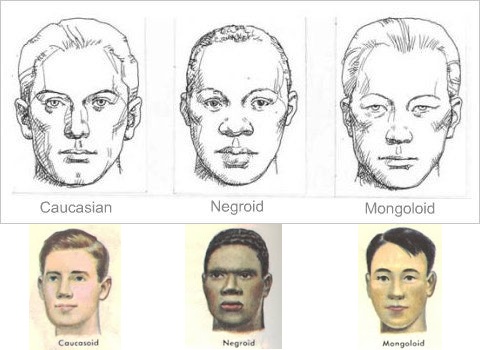 |
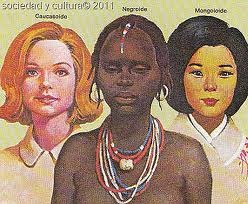 |
And along with the three traditional categories of humans, we can make note of three different types of hair that can be described in general terms as curly, wavy, straight; thin, normal, thick; fine, medium, coarse; thickness, texture, color; thickness, continuity, opacity; languo, vellus, terminal... and variations which might be considered a separate category an extension of one or more of the first three mentioned in a series, as is portrayed in the Wikipedia article: Hair
But with respect to the three races specifically, if we look at cross-sections of their hair, we find that the Africans have a ribbon-like (flat) appearance, the Asians have a circular appearance, and Caucasians have a circular-ellipsoid-triangular appearance notably referenced as an "accentuated ellipsoid", despite all hair giving the appearance of being linear or shaped to give a circular or triangular (pyramidal) appearance. Hence, we see another representation of the linear, circular and triangular configuration that some may suggest defines a developmental trend representing changes in environmental pressures, ... of which the incremental deterioration of the Sun-Earth-Moon planetary configuration is very much a part thereof.
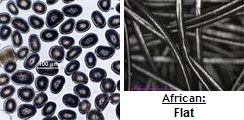 |
 |
 |
Hair Workshop
Hair growth occurs in cycles consisting of three phases:
- Anagen (growth phase): Most hair is growing at any given time. Each hair spends several years in this phase.
- Catagen (transitional phase): Over a few weeks, hair growth slows and the hair follicle shrinks.
- Telogen (resting phase): Over months, hair growth stops and the old hair detaches from the hair follicle. A new hair begins the growth phase, pushing the old hair out.
 Anatomy and Physiology I by Susan Gossett |
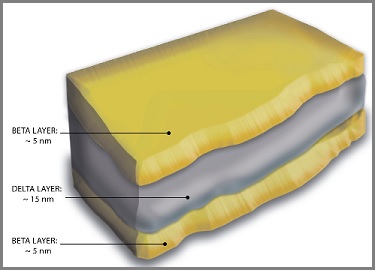
3 types of cell membrane complex of the cuticles:
Dr. Ali N. Syed: The Science of Hair Care |
3 types of brains:
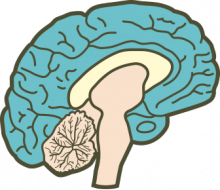 The New Brain: This brain thinks. It processes rational data and shares its deductions with the other two brains. |
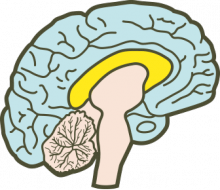 The Middle Brain: This brain feels. |
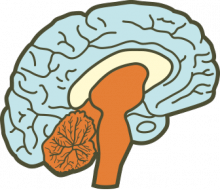 The Reptile Brain: This brain decides. |
Clearly the "sales brain" organizes materials and ideas in terms of a camouflaged predatory focus since reptiles are not known for decision making but for lack of impulse control seen in criminals and relying on behaviors often noted as instincts.
If we contrast the above three-brain description with that of others, we find alternative views:
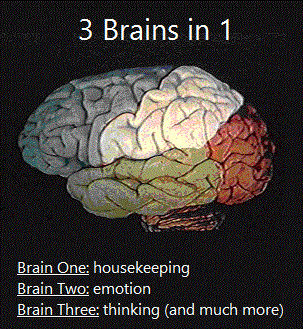
| Where? | Name | Typical Animals | |
|---|---|---|---|
| Brain One | Center of the Brain | “R complex” | snakes, lizards |
| Brain Two | Wrapped around Brain One | “limbic system” orold mammalian brain” | dogs, cats |
| Brain Three | Outside SurfaceWrapped around Brain Two!) | “neocortex” | primates, especially human primates |
Whereas some prefer to focus on three types of brain, others prefer to put the brain into a quadrant of types, a quintuplet according to senses, or according to intelligence formulated by observations and interest, whereby multiple intelligences might be pointed out (sometimes considered as a cover-up by those who have displayed a conventionally average I.Q. on standardized I.Q. tests which only test for very narrow results of human ability). However, one's usage of part, type, section, form, etc., can reference different views of the brain, with one or more being rejected as invalid to some viewers when asking a general question about the brain.
A pattern-of-one reference Various brain model images |
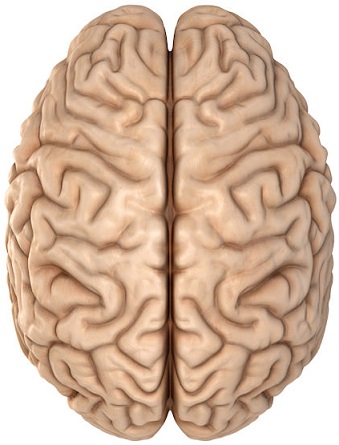 |
A pattern-of-three reference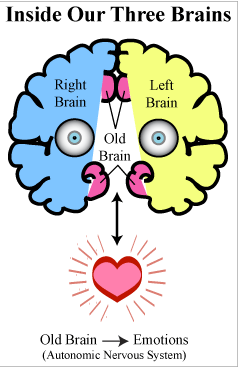 Mind Reach Library: Inroads to the Cosmic Order |
A pattern-of-three reference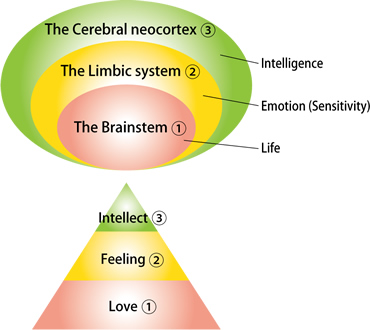 Art of the Ability Development |
A pattern-of-four reference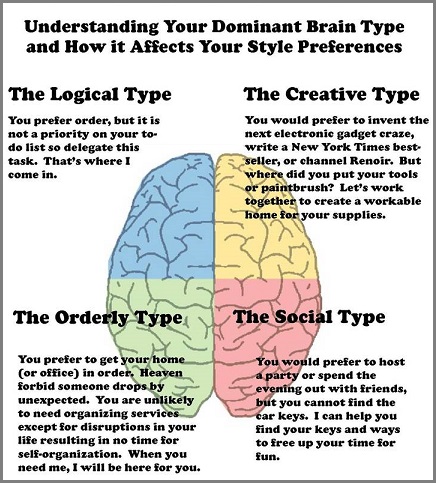 The Practical Sort LLC (Eco-Organizing solutions) |
A pattern-of-five reference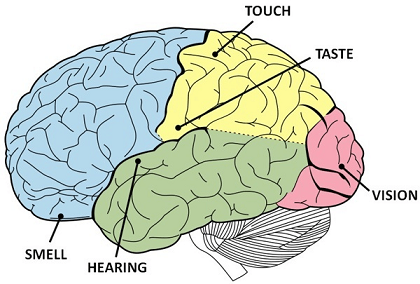 10 surprising facts about how the brain works |
A pattern-of-six reference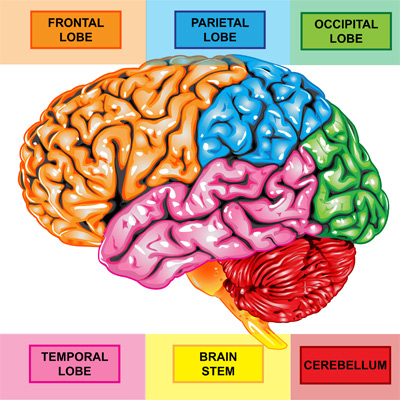 Brain Injury Alliance: Cognitive Skills of the Brain |
A pattern-of-seven reference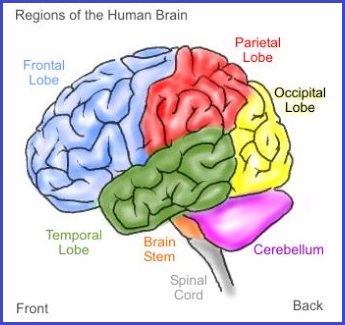 Human biology and health |
Gardner’s Multiple Intelligences
Howard Gardner’s Theory of Multiple Intelligences |
The 3 meninges of the brain (within three sections):
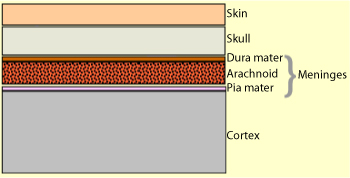
The brain from top to bottom
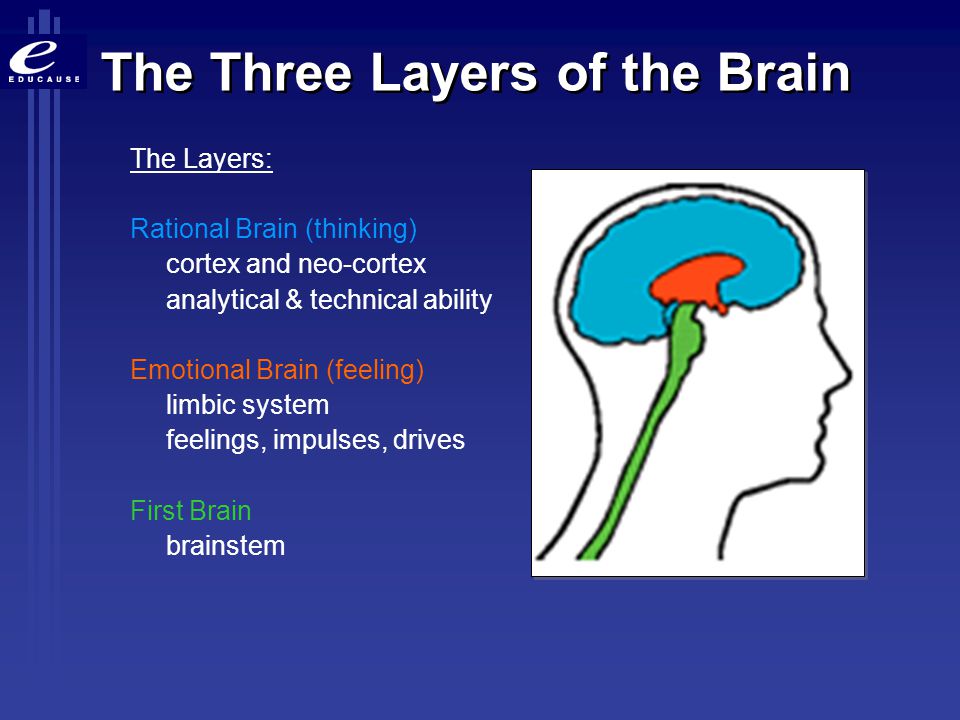
Balanced Leadership: The Role of Emotional Intelligence
Like wise, though you may disagree with the archaeological divisions of the three ages or include the Stone Ages' three separate periods— Paleolithic Period, Mesolithic Period, and Neolithic Period—based on the degree of sophistication in the fashioning and use of tools... to give the impression of there being more than three considerations as if to suggest a greater sophistication of analysis; the "three" is being used and not some other pattern or word in order to describe "diversity" and hence presuppose a complexity that ends up being a researcher's all encompassing dead-end because some value that is believed to be more than the traditional "three" is the "many" of a primitive's counting sequence. In other words, ending up with the usage of a word such as "diversity" to explain a collective perception is like a primitive person being unable to count past it. It is an example of incrementally achieved stopping points just as was the value of one, then of two, then of three... just as we designate the recurrence of this underlying mental stopping behavior by using a comma to separate the hundreds place from the thousands.
In their own language equivalent way, different peoples used different words to describe mental limits in their counting ability. At one time, the word for the quantity "1" represented the limit of quantity. Later on a word for the quantity "2" became that which represented the furthest a given people reached in labeling a one-to-one correspondence of quantity, despite the presence of additional fingers and toes which could have been used if a word or number relationship had existed. Later on, the "three" became identified with the reference of "many", though it may have been used for the quantity of "2" or even "1" in some instances. This early form of number-word to quantity relationship had intervals in which the human mind could not think beyond itself. There were stopping points in the creation of additional words or symbols. Similarly, we see this in the usage of "Small, Medium, Large" to designate sizes, but no new word is used to describe anything beyond the "large". Instead, we see a repetition in the form of X-large, XX-large, XXX-large... just like primitive peoples repeating a smaller number to represent a larger one, or we do upon reaching the value of "9" (three 3s), or a comma used as a mark of separating the first three number placements (ones, tens, hundreds) from the next three, and so on. Limits in counting... a conservation, show up in various ways. And it doesn't matter if a different culture adopts a different model of pattern designation, since the underlying environmental conditions which force the usage of a conservation approach for maintaining some semblance of equilibrium in an incrementally deteriorating "planetary-scape", ensures the same themes are being reproduced.
|
If we were to look at the development of continents from a physiological frame of mind, Alfred Wegener' theory of Continental Displacement(now referred to as Continental Drift) may come to mind and reveal a pattern-of-three with respect to a 1-2-Many model:
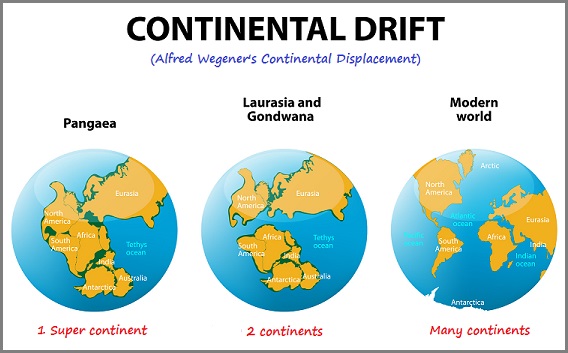
The Enlarging (Growing) Earth Theory
Like certain other scientists before him, (Alfred Lothar) Wegener (born Nov. 1, 1880, Berlin, Germany and died November 1930, Greenland) became impressed with the similarity in the coastlines of eastern South America and western Africa and speculated that those lands had once been joined together. In about 1910 he began toying with the idea that in the Late Paleozoic era (about 250 million years ago) all the present-day continents had formed a single large mass, or super-continent, which had subsequently broken apart. Wegener called this ancient continent Pangaea. Other scientists had proposed such a continent but had explained the separation of the modern world's continents as having resulted from the subsidence, or sinking, of large portions of the super-continent to form the Atlantic and Indian oceans. Wegener, by contrast, proposed that Pangaea's constituent portions had slowly moved thousands of miles apart over long periods of geologic time. His term for this movement was die Verschiebung der Kontinente (“continental displacement”), which gave rise to the term continental drift. Wegener first presented his theory in lectures in 1912 and published it in full in 1915 in his most important work, Die Entstehung der Kontinente und Ozeane (The Origin of Continents and Oceans). He searched the scientific literature for geological and paleontological evidence that would buttress his theory, and he was able to point to many closely related fossil organisms and similar rock strata that occurred on widely separated continents, particularly those found in both the Americas and in Africa. Wegener's theory of continental drift won some adherents in the ensuing decade, but his postulations of the driving forces behind the continents' movement seemed implausible. By 1930 his theory had been rejected by most geologists, and it sank into obscurity for the next few decades, only to be resurrected as part of the theory of plate tectonics (q.v.) during the 1960s. Source: "Wegener, Alfred Lothar." Encyclopædia Britannica Ultimate Reference Suite, 2013. |
Likewise, placed into the present context, Imagine anyone attempting to gather related information occurring in different subjects from a variety of sources to be used to postulate a theory about the "drift" occurring in humanity due to an incremental deterioration. If we suggest that different ideas are like different continents that once had a singular origin but have drifted apart and given different labels— but all of which can be collectively designated as patterns, why can't the brain as well as mind of humanity be viewed in a similar frame of reference since we see an expansion of the brain and parts of the brain drifting into cerebral spinal (fluid) waters where separate distinctions are being explored and mapped? Do geological and larger planetary processes which effected a change in the structure of the once singular land mass into multiple ones, simply stop working once they encounter the anatomy of biological life forms? Can't the same processes, relative to that which is under consideration, also affect biological activity that thus affects mental processes? Why is it we are reluctant to take into consideration that the resulting effects of a 16 ounce metal hammer falling from a height of one foot against a coconut will be different upon a walnut or tomato... each of which would thus show a representative "expression" of the complexities or simplicities involved? In other words, different number patterns, to take but one example, can collectively be described as snowflakes, though some prefer to make distinctions based on intricacy of design due to differences in the individual contingencies of growth. The metaphor, as an analogy, is not that difficult to understand.
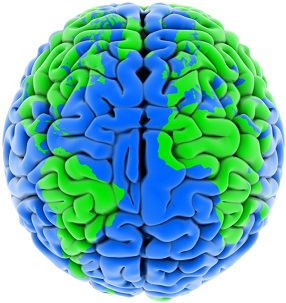 With respect to its type of malleability (like a particular form of modeling clay, stone or other medium), the Earth is subjected to conditions of the planet which makes impressions on it to create some representation which "speaks" with a tongue whose language does not articulate in the manner we are accustomed to hear vocalizations. (Like someone who says they need to put on their glasses in order to fully understand what a person is saying, since many people speak with non-verbal gestures.) |
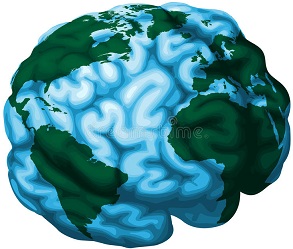 Like an artistic or poetic expression, the different sections of the human brain can be imagined to represent divisions of the Earth caused by geological and larger inter-planetary pressures (forces) over time. The placement of the different continents with their respective habitats, can be interpreted to represent the different sections of the human brain and the qualitative characteristics we attribute to them. |
Page initially created: Friday, 19-August-2017... 3:35 AM
Initial Posting: Sunday, 13th-May-2018... 7:23 AM
Updated Posting: Monday, 13th March, 2023... 11:44 AM
Herb O. Buckland
herbobuckland@hotmail.com